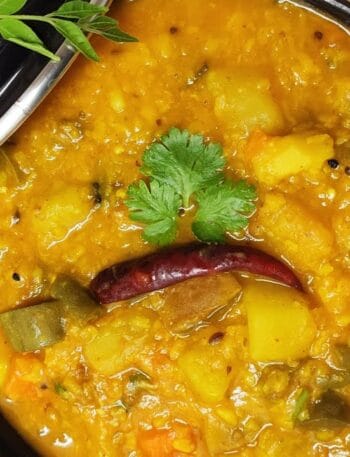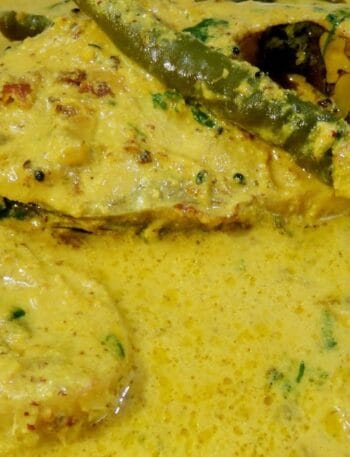Origin and Cultural Significance:
Habisa Dal holds deep cultural and spiritual significance in Odisha, especially during Kartika Masa (October-November), the most auspicious month in the Odia Hindu calendar. During this time, many devotees, especially older women called Habisa Brata Karinis, follow a month-long religious fast known as Habisa Brata to worship Lord Jagannath, the main deity of the famous Jagannath Temple in Puri.
As part of this ritual, devotees follow a strict vegetarian diet consuming sattvic(pure) meals free from onion, garlic, or other strong-flavoured ingredients. In temples, especially the Jagannath Temple, Habisa Dal is often cooked in large quantities and served as part of community meals, where thousands of devotees are fed. Sharing this meal is considered a sacred act, believed to bring blessings from the deity.
Religious Practices and Rituals:
- Devotees often prepare Habisa Dal as a key offering during Annadanam (food distribution) at temples, especially the Jagannath Temple in Puri, where thousands of devotees are served daily.
- The dish is typically consumed with arua bhata (plain rice) and saga bhaja (stir-fried greens), forming a wholesome, balanced meal that aligns with Ayurvedic dietary principles.
- In some regions, special prayers and group meals are organized at temples or community centres, reinforcing a sense of communal sharing and devotion.
Symbolic Meaning:
- Habisa Dal is one such traditional preparation, symbolizing simplicity, purity, and spiritual dedication
- This version of Habisa Dalma is traditionally made without turmeric, which is a key restriction during the Habisa fast, observed by widows or during certain religious observances.
- Its warm, nourishing nature is considered ideal for the cooler post-monsoon season, providing strength and sustenance during the fasting period.
- Traditionally, cooking and sharing Habisa Dal is also believed to earn spiritual merit, as feeding others is considered a noble act in Odia culture.
Thus, Habisa Dal is more than a festive dish—it’s a cultural legacy that represents devotion, communal harmony, and Odisha’s age-old tradition of honouring food as a sacred offering.
Equipment Needed:
Pressure cooker or pot for cooking dal and vegetables.
Pan or small frying pan for tempering (tadka).
Ladle or spoon for stirring.
Chopping board and knife for cutting vegetables and grating
Grater for coconut and ginger.
Strainer to rinse and drain dal and vegetables.
Measuring cups and spoons for accurate ingredient quantities.
Serving bowl for presenting the dish.
Wooden or silicone stirring spoon for mixing.
Gas stove or induction cooktop for cooking.
You may use a mortar and pestle to grind spices or ginger, though it’s not necessary.
Tongs (optional) for handling hot utensils or ingredients.
Cooking and Preparation:
Ingredients:
Moong Dal (Yellow Lentils) – 1 cup (this dal is commonly used for its light, easily digestible nature)
Elephant Foot Yam (Suran) – 1/2 to 1 cup, peeled and cubed
Colocasia (Arbi) – Peel and Chop in Cube, ½ to 1 cup
Raw Banana – 1, peeled and sliced into pieces
Elephant Apple (Chalta) – 1, peeled and cut into pieces (optional, but traditional in some recipes)
Grated Coconut – 1/4 to 1/2 cup (for added flavor and texture)
Grated Ginger – 1-2 teaspoons (for a spicy, aromatic touch)
Ghee (Clarified Butter) – 2-3 tablespoons (for tempering and flavor)
Salt – To taste
Green Chilies – 1-2, slit (for mild heat, optional)
Instructions:
Step 1: Prepare and Cook the Dal
- Wash the Moong Dal: Rinse the Moong Dal thoroughly under running water to remove any dirt and excess starch.
- Cook the Dal: In a pot or pressure cooker, combine the rinsed dal, 2 cups of water, and a pinch of turmeric. Cook until the dal becomes soft and can be easily mashed.
- Tip: Stir the cooked dal to make it smooth and consistent.
Step 2: Prepare the Vegetables
- Cut and Boil: Peel and cube the elephant foot yam, colocasia, and raw banana into even-sized pieces for uniform cooking. If using an elephant apple, prepare small, manageable pieces.
- Cook the Vegetables: In a separate pot, boil the vegetables with a pinch of turmeric and salt until tender but not mushy. Drain and set aside.
- Rationale: Pre-cooking the vegetables prevents them from breaking apart when mixed with the dal.
Step 3: Make the Tempering
- Heat Ghee: In a pan, warm the ghee over medium flame until aromatic.
- Add Spices: Add cumin seeds and allow them to splutter, releasing their nutty aroma. Toss in the bay leaf for an earthy undertone.
- Aromatic Additions: Add grated ginger and green chilies (if using). Sauté briefly until fragrant, ensuring the ginger doesn’t burn.
Step 4: Combine and Simmer
- Mix Dal and Vegetables: Transfer the cooked dal and pre-boiled vegetables into the pan with the tempering.
- Add Coconut: Stir in grated coconut for a creamy texture and subtle sweetness. This step enhances the authentic flavour.
- Simmer: Adjust the consistency by adding water as needed. Simmer for 5-10 minutes on low heat to allow the flavours to meld.
- Rationale: Slow cooking helps the ingredients absorb the spices and seasoning evenly.
Step 5: Adjust and Finish
- Seasoning: Taste and adjust salt as needed.
- Final Touch: Drizzle a spoonful of ghee on top for an extra layer of richness and aroma.
- Rest: Let the dish rest for a few minutes before serving to allow the flavours to settle.
Serving Suggestions:
Cook the Dal: In a pot or pressure cooker, cook the moong dal with water (about 3 cups). Cook until soft but not mushy. If using a pressure cooker, cook for 2-3 whistles on medium heat.
Cook Vegetables: In a separate pan, boil the elephant foot yam, colocasia, and raw banana until tender. You can also add the elephant apple if you’re using it. Drain excess water.
Prepare Tadka (Tempering): Heat ghee in a pan. Add cumin seeds, bay leaves, peppercorns, and a pinch of hing. Once the seeds splutter, add the grated ginger and slit green chillies, and sauté for a minute until fragrant.
Combine Dal and Vegetables: Add the boiled vegetables to the cooked moong dal. Stir well to combine, and cook on low heat for a few minutes to allow the flavours to meld.
Add Coconut: Add the grated coconut to the dal mixture, stir, and cook for another 5-7 minutes.
Adjust Seasoning: Add salt to taste. If desired, garnish with fresh coriander leaves or a squeeze of lemon juice for extra freshness.
Accompaniments for Habisa Dal:
Rice – Plain steamed rice is a classic accompaniment that pairs well with the dal.
Coconut Chutney – A mild chutney made with grated coconut, green chillies, and a touch of salt, which complements the flavours of the dal.
Saag (Leafy Greens) – A simple sautéed dish of leafy greens like spinach or mustard (without garlic or onions) can balance the meal.
Pickles (without garlic) – A tangy, spicy pickle (typically made from raw mango or lemon) can add flavour and zest.
Chapati or Paratha – Soft, unleavened flatbreads made from whole wheat flour that can be served alongside dal.
Yogurt or Curd—A small bowl of fresh yogurt can serve as a cooling side dish, balancing the spice and richness of the dal.
Fried Snacks (optional) – Certain fried snacks like bhajia or papad (fried lentil crisps) can be served for crunch.
Beverage Recommendations for Habisa Dal:
1. Traditional Pairings
- Chaas (Buttermilk): A cooling and digestive drink, chaas complements the simplicity of Habisa Dal. You can flavor it lightly with roasted cumin powder and rock salt.
- Pakhala Water: Leftover water from fermented rice, common in Odisha, is a tangy, probiotic-rich drink that goes well with Habisa Dal.
2. Herbal Infusions
- Tulsi Tea: A mild and warm tulsi (holy basil) infusion enhances the spiritual vibe of the meal.
- Lemongrass Tea: A refreshing herbal option that adds a hint of citrusy aroma, balancing the flavors of the dal.
3. Spiced Drinks
- Jeera Pani (Cumin Water): Lightly spiced with roasted cumin and a pinch of salt, this drink aids digestion and pairs seamlessly with the dal’s subtle taste.
- Aam Panna (Raw Mango Drink): If you prefer a tangy and slightly sweet option, aam panna can elevate the meal while staying grounded in Indian flavors.
4. Fruit-Based Options
- Tender Coconut Water: Light and hydrating, coconut water complements the sattvic nature of the dish.
- Bael Sherbet: A traditional Odia drink made from wood apple, bael sherbet’s sweetness and earthiness align with the simplicity of Habisa Dal.
5. Modern Twists
- Light Green Smoothies: A blend of cucumber, mint, and a touch of lime can provide a refreshing yet simple accompaniment.
- Unsweetened Amla Juice: Rich in Vitamin C and mildly tangy, amla juice serves as a detoxifying drink while maintaining the meal’s sattvic integrity.
Dessert Recommendations for Habisa Dal:
Khaja: A crispy and flaky dessert made with flour, sugar syrup, and ghee, offering a crunchy texture to complement the dal.
Chhena Poda: The iconic baked cottage cheese dessert from Odisha, mildly sweet with a caramelized flavor.
Rasabali: Flattened cottage cheese patties soaked in flavored milk, rich yet light.
Manda Pitha: Steamed rice dumplings filled with coconut, jaggery, and sesame, perfect for a sattvic meal.
Kheeri: Creamy rice pudding made with milk, rice, cardamom, and jaggery, comforting and mildly sweet.
Chakuli Pitha with Jaggery Syrup: Soft rice pancakes paired with jaggery syrup, a balanced and simple treat.
Ada Pitha: Rice-flour pancakes stuffed with jaggery, coconut, and cardamom, offering a chewy and mildly sweet finish.
Malpua: Banana and fennel seed pancakes fried and soaked in sugar syrup, a rich yet traditional option.
Chhena Jhili: Syrupy sweet cottage cheese balls, light and delightful.
Atta Halwa: Warm wheat flour halwa made with ghee, sugar, and cardamom, quick and satisfying.
Storage Suggestions:
- Short-term Storage: Keep Habisa Dal at room temperature for up to 6-8 hours, especially if the weather is cool. In warmer climates, it is best to refrigerate after 2-3 hours.
- Refrigeration: Transfer the dal to an airtight container and refrigerate. It can be stored for 2 days. Reheat the dish on low heat, adding a small amount of water if necessary to adjust the consistency.
- Freezing: If you need to store it longer, freeze Habisa Dal in a freezer-safe container It can be stored for up to one month. Let it thaw in the refrigerator overnight, then reheat on low heat before serving.
Tips for Best Storage:
- Avoid adding coconut or tempering if you plan to store the dal. For the best flavour, add these fresh when reheating.
- Cool the dal completely before storing it to prevent condensation, which can lead to spoilage.
Nutritional Profile and Health Benefits:
Rich in Protein: Lentils like moong dal or urad dal provide plant-based protein for muscle growth and repair.
High in Fiber: Vegetables such as yam, colocasia, pumpkin, and raw banana enhance digestion and prevent constipation.
Good Source of Vitamins and Minerals: Contains potassium, magnesium, folate, and vitamins A and C, supporting heart health and immunity.
Low in Fat: Made with minimal ghee, it remains light yet nourishing.
Easily Digestible: Ingredients like moong dal and mild spices make it suitable for all, especially during fasting.
Rich in Antioxidants: Vegetables and turmeric boost overall health and reduce inflammation.
Sattvic and Wholesome: Free from onion, garlic, and heavy spices, making it suitable for spiritual practices and detox.
In conclusion:
Habisa Dal is not just a nourishing dish but also a vibrant cultural tradition deeply rooted in the spiritual practices of Odisha. Its simple yet flavorful ingredients embody purity, devotion, and communal harmony, making it an essential part of religious observances like Habisa Brata during Kartika Masa. Combining moong dal, vegetables, and tempering with ghee and spices provides a balanced, sattvic meal that supports both physical and spiritual well-being. Whether shared in temples or enjoyed at home, Habisa Dal is a testament to Odisha’s rich culinary heritage, symbolizing the deep connection between food, faith, and community.




